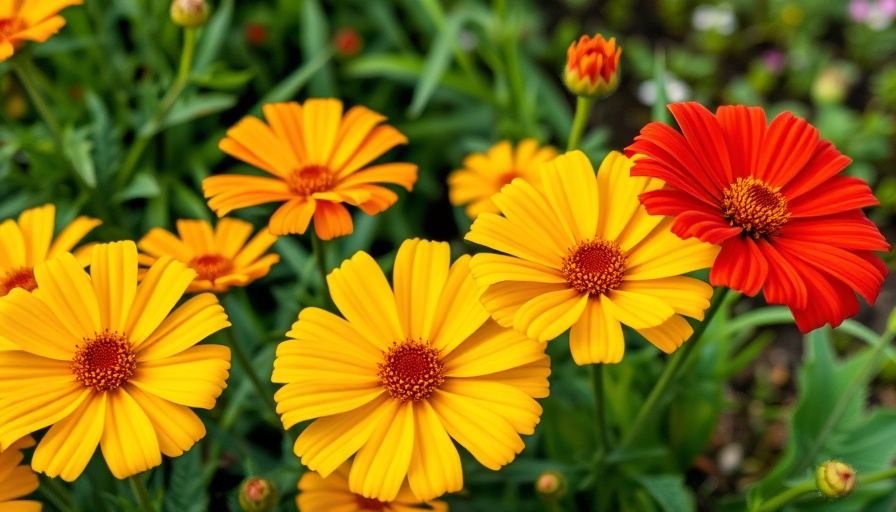
Why Coreopsis is a Gardener's Delight
Coreopsis, often dubbed tickseed, is a flower that brings vibrancy and cheer to any garden. With its historical roots in North America, this perennial favorite exhibits a dynamic palette of colors and forms, making it an essential part of the wildflower garden. Its daisy-like blooms not only attract pollinators but also stand resilient in various climatic conditions, showcasing its adaptability. Whether you're a beginner or an experienced gardener, cultivating coreopsis could enrich your garden and your self-sufficiency journey.
17 Varieties of Coreopsis to Brighten Your Garden
Here's a closer look at 17 popular coreopsis varieties that will surely elevate your gardening experience:
- Amulet: With its bold, golden-yellow blooms, this variety thrives in warm conditions and attracts pollinators.
- Crazy Cayenne: Known for its fiery, orange-red petals, it brings a burst of color to borders and container gardens.
- Double Sunburst: A unique double-flowered version that radiates sunshine in any garden.
- Hot Paprika: This variety boasts dark, rich colors that stand out wonderfully against lush green foliage.
- Mardi Gras: Featuring multi-colored blooms, it’s perfect for adding flair to mixed flower beds.
- Mercury Rising: This tall variety is ideal for back-border planting.
- Moonbeam: Soft yellow blossoms make for a lovely, pastel palette.
- Pumpkin Pie: An autumnal favorite with warm, pumpkin-like hues.
- Radiana Tigrina: Known for its unique texture and vibrant colors.
- Red Chiffon: A stunning take on classic coreopsis with its silky red flowers.
- Red Elf: Great for smaller gardens, this dwarf variety blossoms extensively.
- Red Satin: A non-fading variety with deep red petals.
- Sterntaler: A European introduction that is both charming and hardy.
- Sunburst: Bright yellow blooms reminiscent of sunshine.
- Sunfire: A hybrid that combines vibrant colors with a long blooming season.
- Tall Red: Perfect for garden height variation.
- Zagreb: A dwarf variety vibrant in color and a showstopper in rock gardens.
The Benefits of Cultivating Coreopsis
Growing coreopsis has numerous advantages that align with the principles of sustainable gardening. These flowers are low-maintenance, making them perfect for DIY gardening enthusiasts. With their pest-resistant properties, coreopsis can thrive in various conditions without reliance on harsh chemicals. Additionally, they are excellent for encouraging biodiversity in your garden, attracting bees and butterflies, vital for pollination and enhancing your garden ecosystem. Given these attributes, integrating coreopsis can simplify your gardening efforts and boost your garden's overall health.
Coreopsis: A Gateway to Sustainable Gardening
Whether you're focusing on DIY gardening projects, growing vegetables, or even engaging in shade gardening, coreopsis offers a versatile and attractive option that complements almost any approach. The colorful blooms serve as an excellent ground cover, reducing weeds and protecting soil moisture. Engaging with nature through gardening not only fosters community connection but can also improve mental well-being. Imagine the joy of cultivating your own vibrant garden alive with butterflies and buzzing bees!
Tips for Growing Coreopsis Successfully
Here are some practical insights for successful coreopsis cultivation:
- Choose the Right Spot: Coreopsis thrives in full sun. Select a location that receives at least six hours of direct sunlight daily.
- Soil Type Matters: Well-drained soil is key. Amend your soil with compost to improve drainage and nutrient content.
- Water Wisely: While coreopsis is drought-tolerant once established, it requires regular watering during its initial growth phase.
- Cut Back for More Blooms: Deadhead spent flowers to encourage new blooms throughout the growing season.
Make the Leap into Gardening
Now that you’re equipped with insights on coreopsis, why not take the next step? Explore different varieties and experiment with planting them in your garden space. With the right care and attention, you will be rewarded with a thriving flower bed that not only beautifies your outdoor area but also nurtures local ecosystems. Get started on your journey towards self-sufficiency and enrich your life through the joys of gardening!
Incorporating coreopsis into your gardening plan can open a world of vibrant possibilities. Engage with your community through sharing your blooms, learn sustainable practices, and connect with the earth in a meaningful way. Happy gardening!
 Add Row
Add Row  Add
Add 




 Add Row
Add Row  Add
Add 

Write A Comment